Talismanic Power: How Jewish Jewelry Has Been Used for Protection Through History
More than ornamentation, Jewish jewelry has long served as a shield—featuring Hamsas, Hebrew inscriptions, and Kabbalistic symbols to guard against harm and connect to divine protection.
Ancient Origins of Protective Jewish Jewelry
Long before Jewish jewelry became a fashion statement, it served as something else entirely: a shield, a symbol, a prayer worn close to the skin. In Jewish tradition, jewelry has often held talismanic power—used not just to adorn, but to protect. From the High Priest’s breastplate in biblical times to modern Hamsa pendants, the desire for spiritual safety has shaped the design and meaning of Jewish adornments for thousands of years. In the Book of Exodus, the High Priest’s breastplate was set with twelve sacred stones representing the tribes of Israel, each believed to hold divine energies. These weren’t merely decorative; they were deeply functional, helping to communicate with God and shield the people spiritually.
Amulets and Symbols Through the Diaspora
During periods of exile and persecution, Jews turned to protective symbols embedded in wearable items. In North Africa and the Middle East, Jewish women wore jewish traditional necklaces etched with prayers or Psalms, believed to guard against the evil eye (ayin hara). Babies were given miniature Hamsas, and pregnant women often wore amulets inscribed with angelic names to protect mother and child. One of the most enduring symbols is the Hamsa hand, often worn or hung in homes as a spiritual safeguard. Whether made of brass, silver, or thread, the open palm with an eye in its center was thought to deflect negative energy and attract divine favor. Even today, many wear Hamsa pendants not just for style, but as a quiet invocation of peace and protection. In Eastern Europe, amuletic jewelry sometimes included Hebrew letters or divine names. Kabbalistic symbols—like permutations of the Tetragrammaton or coded verses—were hidden in rings or lockets, believed to ward off illness, misfortune, or spiritual harm.
Modern Talismanic Judaica Jewelry and Its Meaning
This tradition continues into the modern age. Many people today wear necklaces engraved with the Shema prayer or rings inscribed with phrases like “Gam zu l’tova” (“This too is for the good”). These are not seen as superstitions, but as personal reminders and anchors – small sacred gestures that help individuals feel grounded, watched over, and spiritually connected. What makes talismanic Jewish jewelry so compelling is not just its beauty—it’s the quiet power behind it. It’s the sense that when words fail, symbols still speak. When we feel vulnerable, we can reach for something physical worn close to the heart and feel a little more whole. In every culture, people have reached for amulets. But in Jewish history – where faith and survival have often walked hand in hand – jewelry has served not only to express who we are, but to protect who we hope to become.

